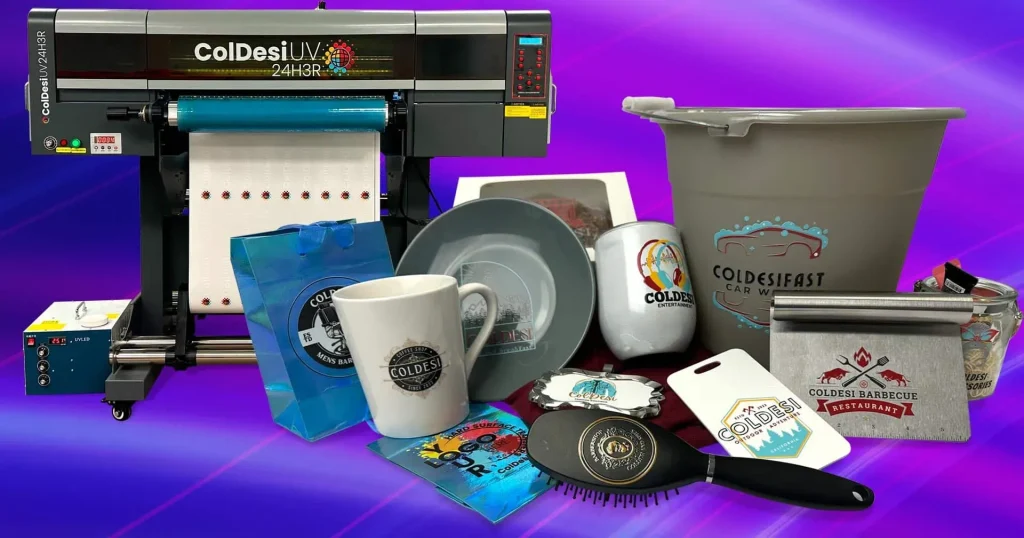UV DTF printing is revolutionizing the custom printing industry by combining the innovative application of UV-cured inks with the direct-to-film process. This advanced printing technology allows for high quality prints that deliver vibrant colors and exceptional durability—meeting the increasing demand for standout products. By employing a meticulous curing process, UV DTF ensures that prints are not only visually striking but also resistant to fading and wear. Proper screen preparation plays a crucial role in this method, as it enhances the print quality by ensuring that inks adhere well to the substrate. In this blog, we will explore the essential techniques and considerations for achieving success with UV DTF printing, ensuring you can create prints that captivate your audience.
The technique known as UV Direct to Film (DTF) printing offers a modern solution for artists and businesses alike, looking to elevate their printing results. By utilizing ultraviolet light to cure inks on specialized films, this method presents a significant leap forward in print technology and ensures longevity and vibrancy for various materials. This innovative approach, commonly referred to in the industry as UV cured printing, emphasizes precision in the curing process while facilitating high-quality results across diverse substrates. As we delve deeper into the realm of UV DTF, we will uncover strategies for optimal screen preparation, the selection of high-quality inks, and the importance of mastering the printing parameters necessary for outstanding outcomes.
The Basics of UV DTF Printing Technology
UV DTF printing is revolutionizing the custom printing landscape by merging the precision and versatility of direct-to-film methods with the powerful performance of ultraviolet inks. This innovative printing technique employs UV-cured inks that are applied directly onto special transfer films, creating prints that are vibrant, durable, and highly resistant to wear. Unlike traditional methods, UV DTF empowers businesses to expand their capabilities by working seamlessly with various substrates, opening doors for new applications and wider market reach.
Beyond just enhancing color vibrancy, the technology used in UV DTF printing promises to significantly improve the longevity of printed materials. The UV curing process provides a hard protective layer that prevents fading and deterioration, ensuring that prints maintain their stunning finish over time. This benefit makes UV DTF printing particularly appealing to businesses aiming for top-tier quality, allowing manufacturers to offer premium products that can withstand the test of time and environmental conditions.
Understanding the Impact of Screen Preparation
Effective screen preparation is a cornerstone of achieving high-quality prints in any printing technique, and UV DTF printing is no exception. A well-prepped screen can significantly enhance print outcomes by avoiding defects that compromise the final product’s appearance. Diligent cleaning using degreasers and brushes will ensure that screens are free from dust and residue, optimizing adhesion of UV inks which directly contributes to the vibrancy and longevity of the prints.
Additionally, regular maintenance of the screens, including checking for areas of wear and replacing emulsion as needed, plays a vital role in sustaining the quality of prints. By establishing a sound screen preparation routine, printers can minimize errors and maximize efficiency, leading to a more reliable production flow and greater client satisfaction. Investing time and resources in proper screen preparation is an essential step in delivering high-quality prints that meet customer expectations.
Choosing the Right Inks for Optimal Results
The selection of inks is crucial in UV DTF printing, as quality directly impacts overall print quality and durability. Manufacturers traditionally offer a range of UV-cured inks specifically formulated for DTF applications, which allows for excellent adhesion properties and vivid color reproduction. These premium inks are designed to work optimally with UV technology, producing prints that not only look outstanding but also resist fading from UV exposure, making them ideal for various applications.
When venturing into UV DTF printing, it’s essential to conduct thorough research to find the right inks based on your specific printing needs and substrate types. Understanding the properties and compatibility of different ink formulations can lead to better print outcomes and reduce potential print failures. By investing in high-quality inks, printers can bring their designs to life with exceptional clarity and color reproduction, ensuring their products remain competitive in the custom printing market.
Navigating the Curing Process for Maximum Print Quality
The curing process in UV DTF printing is crucial as it transforms wet inks into durable, vibrant prints. This step employs UV light to cure the inks instantly, creating a bond that enhances color saturation and print longevity. The efficiency of the curing process can affect the overall quality of the print; thus, maintaining the correct distance between the UV light source and the print is vital for achieving uniform curing across the entire design.
It’s important to experiment with different curing distances and settings to determine the optimal conditions for specific substrates. Careful monitoring of the curing process allows printers to identify issues such as uneven curing or incomplete ink adhesion, helping to prevent defects and ensure that every print meets quality standards. A solid understanding of the curing process fortifies the foundation for producing high-quality prints in UV DTF applications.
Designing Graphics for UV DTF Printing Success
The design phase is a pivotal part of the UV DTF printing process, as it sets the stage for how the final product will appear. Careful consideration of color modes, particularly the CMYK color space, is essential to avoid discrepancies between the design and the printed output. Effective proofing of designs using the software intended for printing can help ensure accurate color representation, which is crucial for meeting client expectations.
Moreover, maintaining a resolution of at least 300 DPI in your designs is necessary to preserve sharpness and detail during the printing process. High-quality graphics will directly translate to high-quality prints. Being meticulous during the design phase not only enhances client satisfaction but also reinforces a printer’s reputation for delivering outstanding results that truly capture the essence of original artwork.
Implementing Quality Control Measures in Printing
Quality control is essential for sustaining high standards in UV DTF printing, and establishing a robust protocol can make all the difference in print outcomes. Regular testing of printed samples is a vital step in identifying any inconsistencies in ink application, adhesion, or print quality. Careful monitoring and adjustment based on these tests ensure that any issues are addressed early in the production process, thereby preserving the overall quality of the prints.
In addition, proper storage conditions for both inks and printed materials should be maintained to prevent unnecessary degradation of quality. By integrating a comprehensive quality control framework, printers can enhance their operational consistency, ultimately resulting in better products and happier clients. This commitment to quality assures that UV DTF printing remains a top choice for those seeking exceptional print results.
Frequently Asked Questions
What is UV DTF printing and how does it achieve high-quality prints?
UV DTF printing, or Ultraviolet Direct to Film printing, is a cutting-edge printing method that combines UV technology with direct-to-film processes. This technique utilizes UV cured inks on specialized transfer films, resulting in vibrant colors, exceptional print quality, and enhanced durability on various substrates, including fabrics, metals, and plastics.
How do UV cured inks improve print quality in UV DTF printing?
UV cured inks are specifically formulated for UV DTF printing, providing excellent adhesion, vibrant color saturation, and resistance to fading. The curing process hardens the inks quickly, ensuring durability and longevity, which enhances the overall print quality and customer satisfaction.
What role does screen preparation play in UV DTF printing?
Screen preparation is crucial in UV DTF printing as it ensures the screen is clean and free from dust and grease. Proper preparation enhances ink adhesion and reduces print defects, contributing to higher quality prints. Regular maintenance of screens is recommended to maintain optimal performance.
What are the key steps in the curing process for UV DTF printing?
The curing process in UV DTF printing involves exposing printed items to UV light, which hardens the inks effectively. Maintaining the right distance between the print and curing unit is essential for achieving an even cure, impacting the durability and print quality of the final product.
How can I choose the right inks for UV DTF printing?
Selecting the right UV cured inks is vital for successful UV DTF printing. It’s best to choose high-quality inks formulated specifically for DTF applications, as they offer superior adhesion and longevity. Research different brands and formulations to find the one that suits your printing needs best.
What considerations should I make when designing graphics for UV DTF printing?
When designing graphics for UV DTF printing, use the CMYK color model and ensure a resolution of at least 300 DPI for sharp details and vibrant colors. Proper proofing in your printing software can help prevent color shifts and ensure that the final print maintains the integrity of your original design.
| Key Aspects | Key Points |
|---|---|
| Introduction | UV DTF printing blends UV technology with direct-to-film processes, offering vibrant colors and exceptional durability. |
| Understanding UV DTF Printing | It uses UV-cured inks on transfer films, suitable for various substrates, enhancing color vibrancy and longevity. |
| Importance of Screen Preparation | Clean screens prevent print defects; regular maintenance is essential for print quality. |
| Choosing the Right Ink | High-quality UV inks designed for DTF ensure better adhesion and resistance to fading. |
| Setting Heat and Pressure Correctly | Medium to high pressure for 15-20 seconds at 320°F to 340°F is typically required, depending on substrate. |
| The Significance of the Curing Process | Curing ensures inks achieve hardness; proper distance from curing unit is crucial for print quality. |
| Design Considerations | Use CMYK color mode and maintain 300 DPI resolution for sharp details and vibrant colors. |
| Implementing Quality Control | Regular quality checks and testing maintain consistency and meet industry standards. |
Summary
UV DTF Printing is revolutionizing the custom printing industry by delivering exceptional prints that combine vibrant colors with durability. By understanding the nuances of the printing process—including meticulous screen preparation, selecting the right inks, and optimizing curing techniques—you can achieve prints that truly stand out. The detailed guidelines and tips discussed are essential for anyone looking to excel in UV DTF printing, helping you create products that not only meet but exceed customer expectations. As the demand for high-quality printed materials rises, mastering UV DTF Printing can distinctly position you ahead of the competition, showcasing your commitment to quality and innovation in every project.



